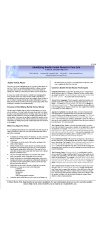Want Employee “Engagement”? Start With Hassle Hunting, A Value Added Process
Contrary to what many executives think, the information essential to improved productivity and efficiency does not reside in the executive suite, but in the minds of the people who actually do the work and interact with the customers. The theme of this is simple. If you want to improve your organization, mobilize each and every employee into becoming a hassle hunter.
On occasion, someone will ask me for my opinion on what makes for successful managers and leaders. I usually respond by asking if they want the long answer (a month of lecture), or the short one. For some reason the asker always chooses the short one, so I try to compress some very complex things into one sentence. Then, I usually make up something on the spot.
It occurs to me that I should have a better answer, or at least one that is short, but really useful to the person who wants to know. I have settled on the notion that what sets apart poor managers, average managers and excellent managers is their effect on workplace hassles. Poor managers create workplace hassles for everyone. Average managers neither create or reduce workplace hassles, while excellent managers reduce hassles for themselves and their employees. Simply put, poor managers are always creating ways to shoot everyone’s feet off, average ones just use the usual ways of shooting feet off, and excellent managers want to stop the amputations.
What Are Hassles?
A workplace hassle can be almost anything, but all hassles have things in common. First, hassles involve avoidable processes, procedures and actions that do not add value to an organization. Second, hassles aggravate everyone (except the person who insists the hassle continue). Hassles interfere with employees’ abilities to do their jobs, they create problems for managers, and often they result in angry or frustrated clients.
Let me list a few things that can be classified as hassles, suggested to me by people from various organizations.
- inadequate signage, causing members of the public to get
- lost, and get very angry, venting the anger on employees.
- requiring staff to submit every piece of written
- communication to the manager for approval, and then having to re-
- write each one.
- requirements to store every word-processed document in paper
- form, when they are also stored in the word-processor.
- voice mail systems that cause more problems than they solve.
- insufficient discretionary power to help the public
- letters written by managers that are so heavy-handed and
- bureaucratic sounding that the recipient has to call an employee
- for clarification, and to vent anger.
- poor planning that results in overstaffing during some
- periods, and understaffing during busy periods.
- procedures that involve six or seven people handling the
- same pieces of paper, with each adding to it.
- meetings that are so poorly run that nobody wants to attend.
Every organization has hassles–procedures, rules, regulations and workflows that are often left over from pre-technology days, or are in place only because it hasn’t occurred to someone that they need to be removed.
The very very odd thing is that hassles, and their sources are common knowledge. The expertise to identify, and solve hassle problems exists in almost any organization, if only there is incentive, a process to dehassle, and confidence that dehassling can be done successfully. The collective knowledge of executives, managers and employees is there.
Producing Hassle-Hunters
Within any work unit, the degree to which people will ferret out hassles will depend on the behaviours of the direct supervisor or manager. Managers can encourage hassle-hunters by putting in place the incentives, and process necessary to funnel employee frustration with hassles into constructive actions. The less effective managers, by neglect, allows that frustration to fester
and damage the organization.
While we will explore the production of hassle-hunters in more detail in future PSM’s, below are a few ways managers can encourage them to take on the challenge.
- reinforce those that bring hassles to the attention of the
- organization, AND are willing to contribute to remove them.
- provide a regular consistent forum for discussing hassles
- harness the frustrations of staff into productive actions
- where staff are responsible for improving things.
- create a climate where team-work can occur since many
- hassles require coordinated effort for the purpose of
- improvement.
- provide necessary resources to address hassles, realizing
- that doing so is a long term investment in efficiency.
- provide employees with training in the use of analytic tools
- to identify and eliminate hassles.
- constantly reinforce and trumpet the importance of service
- and the organization’s mission, and working smarter.
- champion staff generated changes and suggestions to managers
- and executives upline and horizontally to obtain required support
- and resources.
Conclusion
There is no question that hassles create huge amounts of frustration for everyone, and eat up valuable time and money. The only way that hassles can be eliminated is if managers support and encourage their employees to become hassle-hunters.








